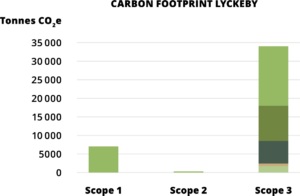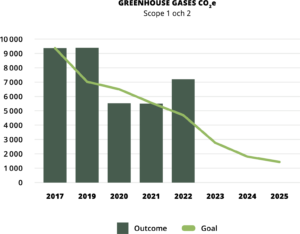A bump on the road to the climate plan
Since 2020, we have replaced a large share of the fossil fuels in our starch production with bio-oil, which has reduced our direct emissions of greenhouse gases. In late summer 2022, however, there was significant uncertainty about energy supplies in Sweden, which meant we temporarily chose to go back to using LPG to secure energy supplies for our increasing production. We did this knowing that in the short term it would increase our carbon dioxide emissions. In turn, this means we have not achieved our goal for 2022. As it turns out, we could have used our stocks of bio-oil, as the energy shortage was wasn’t as dramatic as we had feared, and today we have of course returned to using bio-oil. We intend to continue aiming to achieve our long-term goal of reducing our carbon dioxide emissions in Scope 1 and 2 by 85% for the period 2017–2025.
Lyckeby’s carbon footprint (Scope 1, 2, and 3) for 2022. *Emissions from electricity are calculated using the location-based approach, which is the calculation method we use in our metrics. Using a market-based approach, the equivalent result would be 1250 tonnes of CO2eq. The biogenic emissions were 5,983 tonnes of CO2eq.
In 2022, our emissions of greenhouse gases from energy use in production (Scope 1 and 2) represented approximately 18% of our total carbon footprint.






